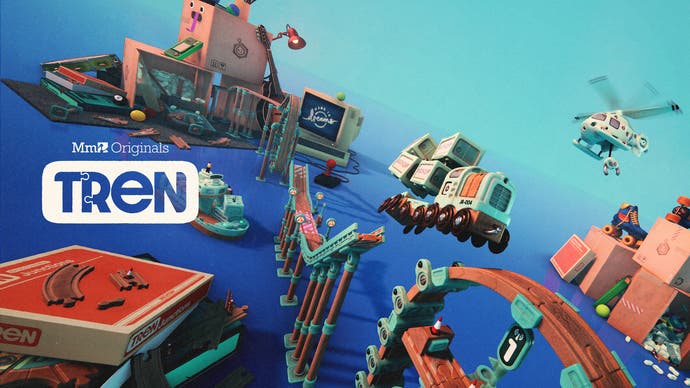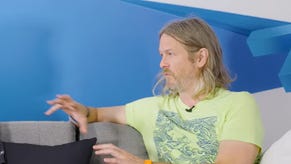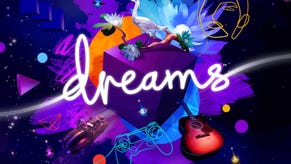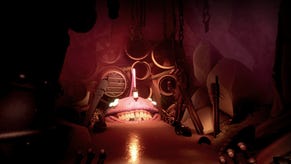Tren, a game within a game, is a window into the spirit of Media Molecule
Choo choo choos your own adventure.
There's a lot of parenting in Tren. This is surprising in some ways, because Tren is ostensibly a virtual train set that comes with a suite of ingenious puzzles and race challenges attached to it. But pull back a little and it starts to make more sense. With Tren, John Beech, the game's design lead, and Media Molecule's newly minted creative director, asked himself if he could make a "triple-A" game inside Dreams, on his own, while simultaneously renovating a house and becoming a parent. The answer, in true Media Molecule style, is that he achieved all of that except for the "on his own" bit, but we'll get to that. For now, welcome to Tren. There's a lot of parenting in it.
And it crops up in a lot of places. Tren drops you into a world of toys and living room floors, and the main attraction is a simple toddler's train set. It's the kind with carved wooden track and chunky vehicles to ride on it, vehicles which all clip together with magnets on the buffers. Even to say these words is to feel the particular weight of these objects in your hands, their pleasant triviality, their painted, planed away smoothness. All great, and Tren delivers on this as you might expect. But my absolute favourite thing about Tren, I reckon, is the moment at which you can attach additional cargo trucks to your train. You maneuver it under a set of plastic cranes, and the arms of the cranes grab the cargo, and then? Then they sort of hover, anxiously, raising and lowering the cargo as they wait for you to get safely into position.
I tell myself: I know this particular anxiety. It's the anxiety, with much attendant arm flippering, that used to erupt whenever my daughter was in pre-school and in the playground attempting something new. I'd hover, not wanting to intrude, but I also couldn't help myself. Yes, it's a lovely slide, but think about safety! I still feel this anxiety now in the odd moment around the house, too, when she asks to try out a fountain pen, say, or asks if she can carry the scissors, very carefully, between rooms. I should let go, and I try to let go - and yet! And yet you get those hovering cargo crane arms, that parental hesitancy, twitching, juddering, urging Tren into the right position, hoping that the whole thing goes well and doesn't become a bad memory.
Of course, I am ahead of myself here, lost in details. But Tren is all details. I had a morning with Tren recently at Media Molecule's newly renovated offices, and this thing, honestly, is a thing of pieces and elements and little bits of business, just like a real toy train set shaken out of a box onto the floor. (Because it's built in Dreams, it is of course a train set too: there's a creative mode with loads of new pieces.) Tren's a thing built of care and attention and with an attitude of simply not being able to stop when it comes to the addition of one more idea, one more gimmick. You get such richness, such strata. Is that a blob of Blu Tack fixing some of the scenery in place as Tren whistles along? Absolutely. Is that a friendly seam of plastic running down the centre of Tren, because in the fiction of this world the chunky plastic body of the train once came from an imperfect mold? 100 hundred percent yes. Is that a hint of the echoing glockenspiel cheer of European train station announcement jingles kicking off the next part of Tren's playful, shifting soundtrack? You betzler it is. Tren is full of this stuff.
Over time, I came to realise that Tren reveals itself in arcs. It has layers. It's like moving outwards through planetary rings, bobbling along with the friendly chunks of ice. So let's go. What's at the centre?
At the centre of it all is Tren, the chunky plastic train with the seam running down the middle and the magnetic buffers for bolting things on. In the game's overworld, Tren runs on a track that's threaded through a series of rooms inspired by Beech's house, mid-renovation. There's lovingly realised drywall, exposed pipes, and even house bricks laying around, all wonderfully thick and rough-edged and - of course - stamped with the Media Molecule logo in the central depression. This overworld is a delight in itself: an unfolding space shaped by the kind of scattered domestic chaos early Speilberg was so good at invoking. But every now and then on the track there are hubs that you can move Tren onto, and then you're whisked off to a challenge level.
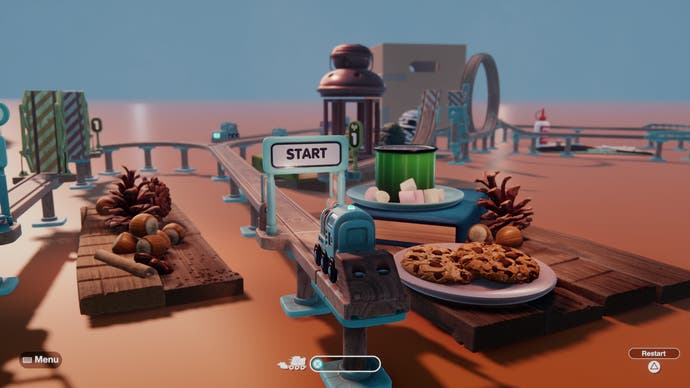

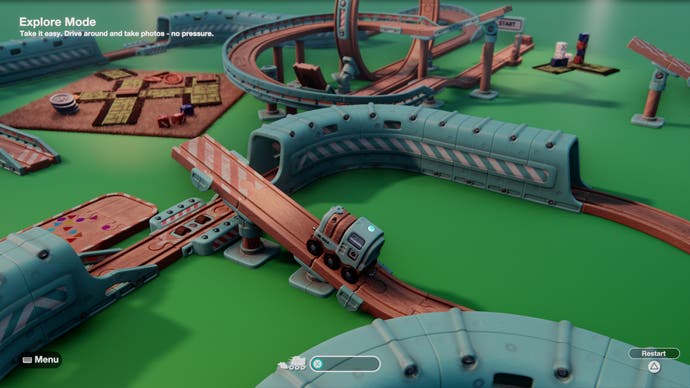
This is where most of the game takes place, I think. Start at the beginning of the track, get to the end goal, but do so by navigating a challenge of some kind. These start simply, with points which allow you to switch between different tracks by flicking a thumbstick as you approach them. Then there are pressure switches to run Tren over which might open a barrier somewhere else on the track. At this point it's clear why you've got one trigger to go forward and another to go backwards: Tren is not a straight-ahead train game, but rather one about backtracking, shunting, navigating complex routes.
Onwards! Tren's toylike immediacy, the sheer force of recognition that each of its pieces inspires, allows it to scale in complexity quite cheerfully. Soon challenges require players to place Tren on parts of the track that can be lifted up and down or moved sideways to make new connections. There are barriers that will only open if Tren is carrying a certain amount of cargo, or if the engine did a certain number of mid-air flips - yes, Tren has air control - after exiting a ramp. Some of the best puzzles are really simple: I loved one in which Tren would only connect with the right piece of track if they were moving very, very slowly at a junction. Some of them are dazzlingly complex. A late level of Tren might include magnet tracks, deadly hurdles, inertia puzzles, loop-di-loops and sections in which you have to take control of a little plastic helicopter and fly about the world looking for new sections of rail to drop into gaps.
What a trajectory. An early level is done in seconds. A gimmick, and then a nice drop towards the finish line, and a chance to pick over your stats: how fast you were, how much cargo survived, how many flips you achieved. But by the end - honestly, one of the later levels reminded me of Trials. Tren becomes a kind of endless shifting weight calculation. Do I have enough speed to send me up this loop? Can I flip backwards and end up on a separate piece of track? Should I use the boost at this switchback or will that lead to a derailment? As a sort of puzzle racer, it's filled with ideas and perfect for speedrunning. Tren!
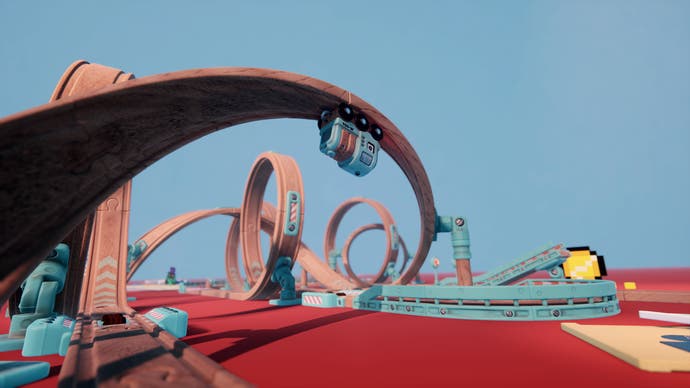
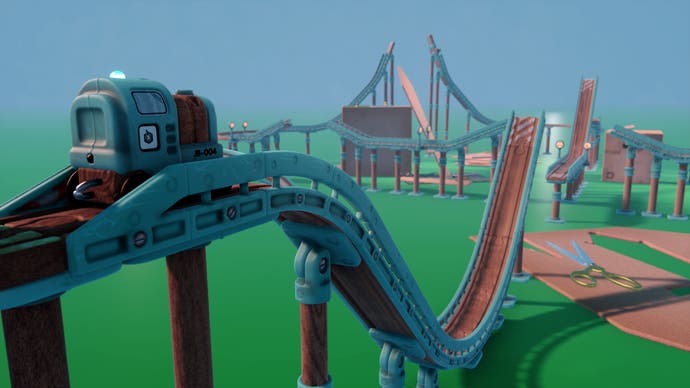
Move back, though, and you start to get the wider charm of the thing. You're not controlling a train, after all, but a toy train, and so the world around the train tracks is often littered with other toys too. Not just toys but stuff, actually: a classic finish line will be covered in packing noodles for you to plough through, or will drop you down into a trash can with one of those basketball hoops for balled-up paper attached. Victory!
But the toys. Here's where the layering of narrative, of themes and preoccupations begins, I think. Early levels have old toys: tin airplanes, wooden trees. Move forward and you get to the plastic action hero boom of the 1980s, then a layer of handheld games machines with their grubby screens and bright plastic joysticks. Move forward and you get stickers, building blocks, craft sets. Graph paper. Geometry tools. It's the strata of childhood, and as such it blends the intensely recognisable with the slightly strange. All these separate worlds of separate childhoods converging here, because we're on the floor of a giant playroom, and Tren is moving us back and forth.
It's not just an exercise in nostalgia. I suspect it's more than that: Tren's a game that's actually about nostalgia, about the way memories change as time and tastes change, and about the way certain elements that remain fixed. It's joyful and also slightly melancholy, and these toys lying around the tracks are not just set dressing.
"Because I was so inspired by my own life," Beech tells me, a man of easy passions, so everything comes tumbling out without finger spaces between the words, "I told anyone who came onto the Tren team, I told them directly: I want you to put as much of you as you can in here." He nods to himself. "So all the artwork you see, they're Jon Eckersley the art director's toys and he was putting them in there. Christophe Villedieu, one of the main designers, he's been making a game on Dreams called Vector Majoris, and one of the levels has a whole plastic kit of his spaceship. Everyone put as much of themselves in there."
Once Beech had opened Tren out to a wider team of developers at Media Molecule, he wanted everyone's memories of toys, their own favourites, scattered in amongst his, and this gave Tren its distinctive texture, buzzing with life, but somehow simultaneously unhurried. Plane-spotting guide books. PC monitors hosting attract screens for adventure games (Robinson Clouseau: A Murder Mystery All at Sea). It's lightly fictionalised, but it's also personal, and there's a lovely tension here, between the specific and the general, between personal autobiography and a team effort.

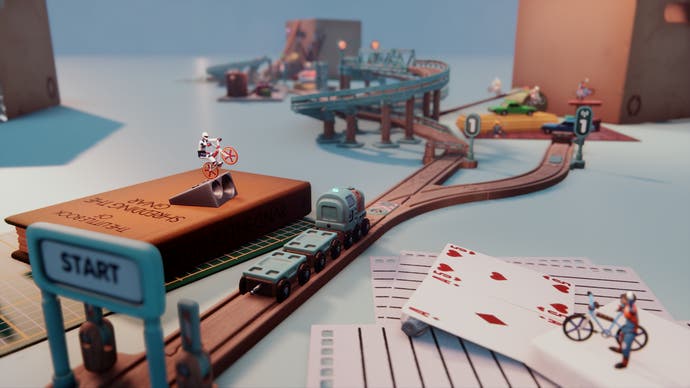
The more I played the more I spotted what felt like another layer to things. In amongst the curving, twisting tracks and the surrounding landscape of treasured plastic and wood, I'd spot these little people: not quite toy soldiers, more like Subbuteo players freed from their little macaroon stability disks of plastic and dressed up in all sorts of outfits. They're Blu Tacked around or balanced on books and blocks, often acting out little dioramas, which, taken level-by-level start to tell their own stories or build up new themes.
Early on, it really is all parenting. Lots of parents and children: parents pointing while a kid looks through a telescope, say, or a parent cheering as a child noses a mountain bike down a slope made of old school rulers. I was sure that one early level was back into helicopter parenting territory: that point in parenthood where you know you have to let go a bit, but it's so hard, and the world still seems so sharp and deadly.
In truth, Beech tells me later, there are dozens of personal stories folded into Tren. As he encouraged his team to fold in their favourite toys, they also folded in their stories. What I love about this is that I didn't feel like I had to understand these stories to tell that they had meaning, and that's intentional too.
"It was very important that everyone has their own take on nostalgia, on what's important to them," Beech tells me. "So we left it weirdly as blank as we possibly could so people could get their own story from it. We weren't imprinting exactly our story.
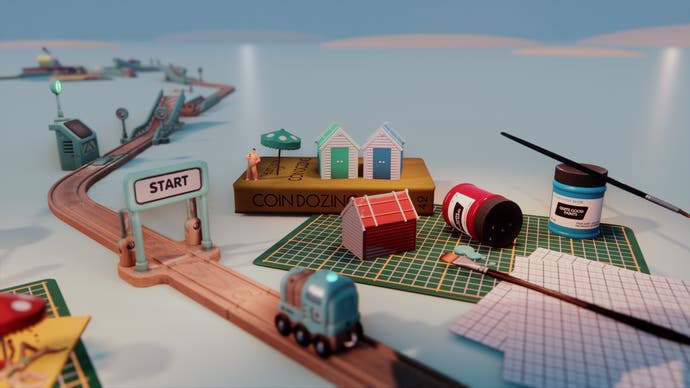
"Specifically in cluster three," he continues, "my parents got divorced when I was quite young and you'll see that played out just as these tiny little characters. You can either zoom by as Tren and do these stunts, or you can go into photo mode and just look. And if you look at the characters in each of the clusters they tell these stories - if you want to have a look at them." Was that difficult for him? "They're detached enough from me that you can take your own meaning from it," he says with a frown, "but the sincerity of the story exists on the underneath, which is what makes it feel real as you're going through, and is what allows you to imprint your version on it. Because there is that underlying sincerity." I am old now. I have been to each one of Media Molecule's offices, I think, even the first one which was above a bathroom store and far removed from this airy, colourful modern space with a moss wall by reception and a fiddle leaf fig in a hallway. I remember once being there and learning about a new hire - someone who had come to design from the Little Big Planet community, someone who, it turned out, had been a builder in real life, working in actual construction.
This was Beech, it turns out. And he's now creative director. And that's the final layer of Tren for me today. Over the last few years, Media Molecule has seen a fair amount of change, including the departure of co-founder Mark Healey, and the recent announcement that the studio will cease live support of Dreams in September of this year as it shifts focus to "an exciting new project". And now, a new creative director. So how has that been? And can people look at Tren as a sign of what's to come? A sign of what Beech finds valuable and core to the team?
"It's really important to respect the past if you're going to look forward to the future," Beech tells me at one point, explaining why there are nods to Tearaway and LittleBigPlanet in Tren, but also speaking to something wider. It's a point he returns to later. "Media Molecule is where I got my first job after being a builder," he says, reminding himself, it seems. "I learned how to become a game designer from all the amazing people at Media Molecule and that has never changed. People come and people go, but the core is the people that exist in this place. Tren for me is just an extension of that. I was leading Tren, but it was really about the collaboration, and that was and is what Media Molecule is always about."
Siobhan Reddy, the studio director, agrees. "We're eighteen in January," she says, looking slightly alarmed at the realisation. "Things have gone through lots of changes in that time. We've had LittleBigPlanet, Tearaway, Dreams. I think the threads [that run through it] are it being about people, finding ways to collaborate, build communities, enable player expression, all those things are still there.
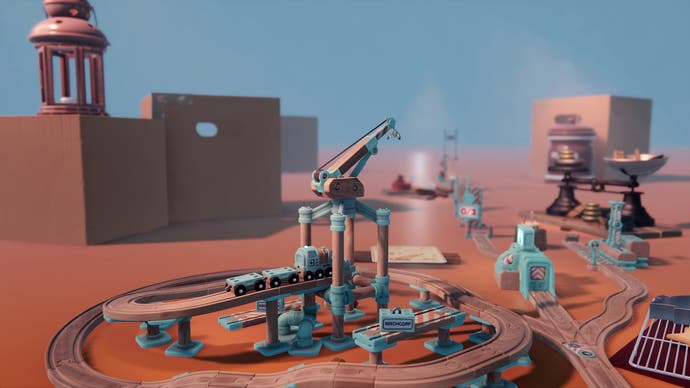
"Culture's not static," she continues. "Over those years we've had moments where things have been absolutely amazing, and moments where things are really tough. But we try to regroup ourselves, to come back to those set of values that we have around collaboration and people and creativity. And creating something where people can see a bit of themselves."
Now she nods to herself. "Even over the past few years as we've been looking at various different things, we come back to this idea: when we say collaboration, we kind of mean it in a very strong way. It means we're comfortable really talking about things and bringing people from different parts of the studio. Tren's our most recent example and John's done a stellar job - of showing us the way, again. How we can collaborate and make something. And it's definitely influencing how we make other things."
